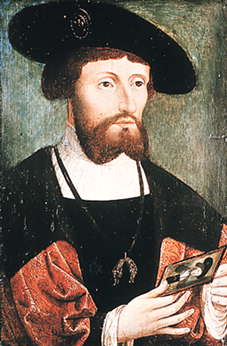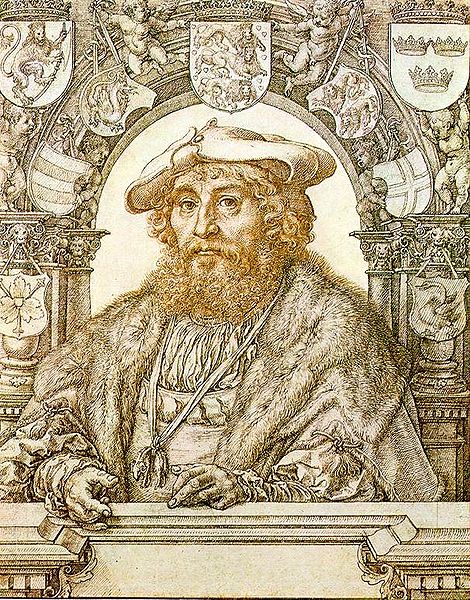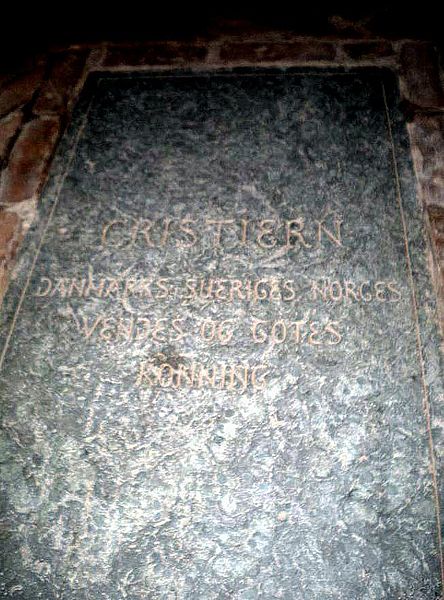<Back to Index>
- Physician Ignác Fülöp Semmelweis, 1818
- Architect Josep Lluís Sert i López, 1902
- King of Denmark, Norway and Sweden Christian II, 1481
PAGE SPONSOR



Christian II (1 July 1481 – 25 January 1559) was King of Denmark, Norway (1513 – 1523) and Sweden (1520 – 1521), during the Kalmar Union.
Christian was born as the son of King John of Denmark and Christina of Saxony, at Nyborg Castle in 1481 and succeeded his father as king and regent in Denmark and Norway, where he later was to be succeeded by his uncle King Frederick I of Denmark.
Christian descended, through both Valdemar I of Sweden and Magnus I of Sweden, from the Swedish Dynasty of Eric, and from Catherine, daughter of Inge I of Sweden, as well as from Ingrid Ylva, granddaughter of Sverker I of Sweden. His rival Gustav I of Sweden descended only from Sverker II of Sweden and the Dynasty of Sverker (who apparently did not descend from ancient Swedish kings). Christian took part in his father John of Denmark's
conquest of Sweden in 1497 and in the fighting of 1501 when Sweden
revolted. He was appointed viceroy of Norway in 1506, and succeeded in
maintaining control of this country. During his harsh administration in
Norway, he attempted to deprive the Norwegian nobility of its traditional influence exercised through the Rigsraadet privy council leading to controversy with the latter. Christian's succession to the throne was confirmed at the Herredag assembly of notables from the three northern kingdoms, which met at Copenhagen in
1513. The nobles and clergy of all three kingdoms regarded with grave
misgivings a ruler who had already shown in Norway that he was not
afraid of enforcing his authority to the uttermost. Rigsraadet of Denmark and Norway insisted in the Håndfæstning charter
extorted from the king, that the crowns of both kingdoms were elective
and not hereditary, providing explicitly against any transgression of
the charter by the king, and expressly reserving to themselves a free
choice of Christian's successor after his death. But the Swedish
delegates could not be prevailed upon to accept Christian as king at
all. "We have", they said, "the choice between peace at home and strife
here, or peace here and civil war at home, and we prefer the former." A
decision as to the Swedish succession was therefore postponed. During
his reign, Christian concentrated on his attempts to maintain control
of Sweden while attempting a concentration of power in the hands of the
monarch, at the expense of both clergy and nobility. To further this
attempt, he supported the creation of a strong class of burghers. A
peculiarity, more fatal to him in that aristocratic age than any other,
was his fondness for the common people, which was increased by his
passion for a pretty Norwegian girl of Dutch heritage, named Dyveke Sigbritsdatter, who became his mistress in 1507 or 1509. On 12 August 1515, Christian married Isabella of Austria, the granddaughter of Holy Roman Emperor Maximilian I.
But he would not give up his liaison with Dyveke, and it was only the
death of the unfortunate girl in 1517, under suspicious circumstances, that prevented serious complications with the emperor Charles V. Christian avenged himself by executing the magnate Torben Oxe despite his having been acquitted of murder charges by Rigsraadet. Oxe was brought to trial at Solbjerg outside Copenhagen in what
amounted to a justice - of - the - peace court on vague offenses against his
liege lord, Christian II. The verdict as directed by the king was
guilty and the death sentence imposed with the comment, 'your deeds not
your words have condemned you'. Over the strenuous opposition of Oxe's
fellow peers he was executed at St. Clare's Hosptial Cemetery in the
fall of 1517. Thereafter the king lost no opportunity to suppress the nobility and raise commoners to power. His chief counsellor was Dyveke's mother Sigbrit Willoms, who excelled in administrative and commercial affairs. Christian first appointed her controller of the Sound Dues of Øresund,
and ultimately committed to her the whole charge of the finances. A
bourgeoise herself, it was Sigbrit's constant policy to elevate and
extend the influence of the middle classes. She soon formed a
middle class inner council centering on her, which competed for power
with Rigsraadet itself.
The patricians naturally resented their supersession and nearly every
unpopular measure was attributed to the influence of "the foul mouthed
Dutch sorceress who hath bewitched the king." However, Mogens Gøye, the leading man of the Council, supported the king as long as possible. Christian
was meanwhile preparing for the inevitable war with Sweden, where the
patriotic party, headed by the freely elected Viceroy Sten Sture the Younger, stood face to face with the pro-Danish party under Archbishop Gustav Trolle.
Christian, who had already taken measures to isolate Sweden
politically, hastened to the relief of the archbishop, who was
beleaguered in his fortress of Stäket, but was defeated by Sture and his peasant levies at Vedila and forced to return to Denmark. A second attempt to subdue Sweden in 1518 was also frustrated by Sture's victory at Brännkyrka. A
third attempt made in 1520 with a large army of French, German and
Scottish mercenaries proved successful. Sture was mortally wounded at
the Battle of Bogesund, on 19 January, and the Danish army, unopposed, was approaching Uppsala, where the members of the Swedish Privy Council, or Riksråd,
had already assembled. The councillors consented to render homage to
Christian on condition that he gave a full indemnity for the past and a
guarantee that Sweden should be ruled according to Swedish laws and
custom; and a convention to this effect was confirmed by the king and
the Danish Privy Council on 31 March. Sture's widow, Dame Christina Gyllenstierna, still held out stoutly at Stockholm, and the peasantry of central Sweden, roused by her patriotism, flew to arms, defeated the Danish invaders at Balundsås on 19 March, and were only with the utmost difficulty finally defeated at the bloody battle of Uppsala, on Good Friday,
6 April 1520. In May the Danish fleet arrived, and Stockholm was
invested by land and sea; but Dame Gyllenstierna resisted valiantly for
four months longer and took care, when she surrendered on 7 September,
to exact beforehand an amnesty of the most explicit and absolute
character. On 1 November, the representatives of the nation swore
fealty to Christian as hereditary king of Sweden, though the law of the land distinctly provided that the Swedish crown should be an elective monarchy. On 4 November, Christian was anointed by Gustav Trolle in Stockholm Cathedral, and took the usual oath to rule the Realm of Sweden through
native born Swedes alone, according to prescription. The next three
days were given up to banqueting, but on 7 November "an entertainment
of another sort began." On the evening of that day Christian summoned
his captains to a private conference at the palace, the result of which
was quickly apparent, for at dusk a band of Danish soldiers, with
lanterns and torches, broke into the great hall and carried off several
carefully selected persons. By
10 o'clock the same evening the remainder of the king's guests were
safely under lock and key. All these persons had previously been marked
down on Archbishop Trolle's proscription list. On the following day a
council, presided over by Trolle, solemnly pronounced judgment of death
on the proscribed, as manifest heretics. At 12 o'clock that night the
patriotic bishops of Skara and Strängnäs were
led out into the great square and beheaded. Fourteen noblemen, three
burgomasters, fourteen town councillors and about twenty common
citizens of Stockholm were then drowned or decapitated. The executions
continued throughout the following day; in all, about eighty-two people
are said to have been murdered. Moreover, Christian ordered that Sten Sture's
body should be dug up and burnt, as well as the body of his little
child. Dame Christina and many other noble Swedish ladies were sent as
prisoners to Denmark. When it became necessary to make excuses for the
massacre, Christian proclaimed to the Swedish people that it was a
measure necessary to avoid a papal interdict, while in his apology to
the pope for the decapitation of the innocent bishops he described it
as an unauthorized act of vengeance on the part of his own people. The massacre and deeds in the Old Town of Stockholm is the primary reason why Christian is remembered in Sweden, as Christian the Tyrant (Kristian Tyrann). Christian
II returned to his native kingdom of Denmark, his brain teeming with
great designs. There can be no doubt that the welfare of his dominions
was dear to him. Inhuman as he could be in his wrath, in principle he
was as much a humanist as any of his most enlightened contemporaries.
But he would do things his own way; and deeply distrusting the Danish
nobles with whom he shared his powers, he sought help from the wealthy
and practical middle classes of Flanders. In June 1521, he paid a sudden visit to the Low Countries,
and remained there for some months. He visited most of the large
cities, took into his service many Flemish artisans, and made the
personal acquaintance of Quentin Matsys and Albrecht Dürer; the latter painted his portrait. Christian also entertained Erasmus, with whom he discussed the Protestant Reformation,
and let fall the characteristic expression: "Mild measures are of no
use; the remedies that give the whole body a good shaking are the best
and surest." Never
had King Christian seemed so powerful as upon his return to Denmark on
5 September 1521, and, with the confidence of strength, he at once
proceeded recklessly to inaugurate the most sweeping reforms. Soon
after his return he issued his great Landelove, or Code of Laws. For
the most part this is founded on Dutch models, and testifies in a high
degree to the king's progressive aims. Provision was made for the
better education of the lower, and the restriction of the political
influence of the higher clergy; there were stern prohibitions against
wreckers and "the evil and unchristian practice of selling peasants as
if they were brute beasts"; the old trade guilds were retained, but the
rules of admittance thereto made easier, and trade combinations of the
richer burghers, to the detriment of the smaller tradesmen, were
sternly forbidden. Unfortunately
these reforms, excellent in themselves, suggested the standpoint not of
an elected ruler, but of a monarch by divine right. Some of them were
even in direct contravention of the charter; and the old Scandinavian
spirit of independence was deeply wounded by the preference given to
the Dutch. Sweden, too, was now in open revolt; and both Norway and
Denmark were taxed to the utmost to raise an army for the subjection of
their sister kingdom. Foreign complications were now added to these
domestic troubles. With the laudable objective of releasing Danish
trade from the grinding yoke of the Hanseatic League, and making Copenhagen the
great emporium of the north, Christian had arbitrarily raised the Sound
tolls and seized a number of Dutch ships that presumed to evade the
tax. Thus, his relations with the Netherlands were strained, while he was openly at war with Lübeck and her allies. Jutland finally rose against him, renounced its allegiance, and offered the Danish crown to Christian's uncle, Duke Frederick of Holstein, 20 January 1523. So overwhelming did Christian's difficulties appear
that he took ship to seek help abroad, and on 1 May landed at Veere in Zeeland. During the years of his exile, the king led a relatively humble life in the city of Lier in
the Netherlands, waiting for the military help of his reluctant
imperial brother-in-law. In the meantime, he became regarded a social
saviour in Denmark, where both the peasants and the commoners began to
wish for his restoration. For some time, he even became a Protestant,
but had to re-convert in order to gain the support of the Emperor. Eight
years later, on 24 October 1531, he attempted to recover his kingdoms,
but a tempest scattered his fleet off the Norwegian coast, and on 1
July 1532, by the convention of Oslo, he surrendered to his rival, King
Frederick, in exchange for a promise of safe conduct. But King Frederick did not keep his promise, and King Christian was kept prisoner for the next 27 years, first in Sønderborg Castle until 1549, and afterwards at the castle of Kalundborg.
Stories of solitary confinement in small dark chambers are inaccurate;
King Christian was treated like a nobleman, particularly in his old
age, and he was allowed to host parties, go hunting, and wander freely
as long as he did not go beyond the boundaries of the town of Kalundborg. His cousin, King Christian III of Denmark,
son of Frederick I, died in early 1559, and it was said that even then,
with the old king nearing 80, people in Copenhagen looked warily
towards Kalundborg. But King Christian II died peacefully just a few
days later, and the new king, Frederick II, ordered that a royal funeral be held in memory of his unhappy kinsman, who lies buried in Odense next to his wife, son and parents. Christian
II is one of the most discussed of all Danish kings. He has been
regarded as both a hypocritical tyrant and a progressive despot, who
wanted to create an absolute monarchy based upon “free citizens”. His
psychological weaknesses have caught the interest of historians,
especially his frequently mentioned irresolution, which as years passed
seemed to dominate his acts. Theories of manic depression have
been mentioned, but like many others they are impossible to prove. The
reasons for his downfall were probably that he made too many enemies
and that the Danish middle class was still not strong enough to make up
a base of royal power. However some of his ambitions were fulfilled by
the victory of absolutism in 1660. The king’s life and career have created many myths. One of the most famous is the story of the irresolute king crossing the Little Belt forwards
and backwards during a whole night in February 1523, until he at last
gave up. Another, probably just as unlikely, is the legend that the
restless king wandered around a round table on Sønderborg making
a groove in the table top with his finger. His life has also inspired
modern Danish poets and authors. In Johannes Vilhelm Jensen's novel The Fall of the King (1900 – 1901), the king is regarded almost as a symbol of the Danish “illness of hesitation”.